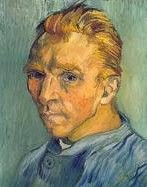 他是19世纪卓越的绘画艺术大师,在世界绘画史上写下了浓墨重彩的一笔。他用绚烂的色彩和挥洒的笔触带给世人无数永恒的画面:如火焰般绚烂的向日葵、星光满天的夜空、翻卷的麦浪……一幅幅无法复制的画作正是他充满苦闷、哀伤、绝望和激情的内心最深处的呐喊。孤寂、贫病交加、被世人误解—饱经苦难的他如同被剪断双翅的飞鹰,虽身陷绝境,却依然热爱飞翔,热爱蓝天上那高远的梦想。正如梵高自己所说:“生活对我来说就是一次艰难的航行……但我将奋斗,我将生活得有价值,我将努力战胜,并赢得生活。”
他是19世纪卓越的绘画艺术大师,在世界绘画史上写下了浓墨重彩的一笔。他用绚烂的色彩和挥洒的笔触带给世人无数永恒的画面:如火焰般绚烂的向日葵、星光满天的夜空、翻卷的麦浪……一幅幅无法复制的画作正是他充满苦闷、哀伤、绝望和激情的内心最深处的呐喊。孤寂、贫病交加、被世人误解—饱经苦难的他如同被剪断双翅的飞鹰,虽身陷绝境,却依然热爱飞翔,热爱蓝天上那高远的梦想。正如梵高自己所说:“生活对我来说就是一次艰难的航行……但我将奋斗,我将生活得有价值,我将努力战胜,并赢得生活。”
“What am I in the eyes of most people—a nonentity, an eccentric, or an unpleasant person—somebody who has no position in society and will never have; in short, the lowest of the low. All right, then—even if that were absolutely true, then I should one day like to show by my work what such an eccentric, such a nobody, has in his heart. That is my ambition, based less on resentment than on love in spite of everything, based more on a feeling of serenity than on passion. Though I am often in the depths of misery, there is still calmness, pure harmony and music inside me. I see paintings or drawings in the poorest cottages, in the dirtiest corners. And my mind is driven towards these things with an irresistible momentum.”
—Vincent van Gogh to Theo van Gogh1),
21 July 1882
“在大多数人的眼里,我也许是一个无足轻重的小人物,一个怪人,一个惹人讨厌的家伙,一个没有社会地位、永远也不会有地位的人——一句话,下等人中的下等人。好吧,就算这一切都千真万确,我也希望有一天能够通过自己的作品表明一个像我这样的怪人和小人物的内心世界。这就是我的理想,虽历经风雨也没有让仇恨蒙蔽仁爱,没有让盛怒取代宁静。尽管我常常陷入凄苦的深渊,内心却依然保留着那一份平静与和谐,永远流淌着美妙的音乐。即使是在最简陋的屋舍内、最肮脏的角落里,我也能发现美的图画、美的素描。我的思想总是带着一股无法抗拒的动力,冲向美的事物。”
——文森特·梵高1882年7月21日致西奥·梵高
He was prolific2) and protean3): He was a scholar and a sufferer, an art-world pro and a destitute outsider, an evangelical4) bohemian, both sordid and sublime. There are as many ways to see his pictures as there are ways to read his life. Some are stolid5) brown and gray. Others seem to detonate6) in a shrapnel burst of color, as if his world had begun to fly apart. Some are piercingly original. Others closely imitate other artists’ art. Apparent in these paintings are the combustible7) components that he mixed in his art.
他多才多产,集多重角色于一身:他是学者,同时也是一个饱经苦难的人;他是艺术界的专业人士,同时也是一贫如洗的圈外人;他是循规蹈矩的福音派教徒,同时又是一个放荡不羁的艺人;他既有贪鄙的一面,又有高尚的情操。有多少种解读他人生的方式,就有多少种欣赏他绘画的途径。他的作品,有的缺乏热情,铺满冷漠的棕色和灰色;有的却热烈无比,色彩像炸开的榴弹喷涌而出,彷佛他的世界也开始随之分崩离析;有的匠心独创,别出心裁;有的则是对他人作品的高度模仿。在这些绘画中,我们一眼就能看出那些他糅合在自己绘画艺术中的、足以点燃人激情的元素。
1. The Painter of Peasant Life 农民生活画家 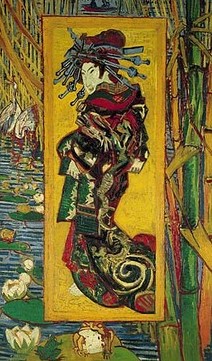 Van Gogh painted among peasants, and in some part of his being he was one himself, as burdened and as earthy as a rustic8) out of9) Bruegel10), as soiled and as coarse.
Van Gogh painted among peasants, and in some part of his being he was one himself, as burdened and as earthy as a rustic8) out of9) Bruegel10), as soiled and as coarse.
His studio in Nuenen11) was between the sewer and the dung heap. His shoes were broken, dirty things, and his mattress was straw. His poverty, his politics, his faith and his aesthetics bound him to the lowly. Van Gogh had preached the Gospel to peat-diggers and weavers, and had knelt in their mud huts, but his manners were not saintly. He smelled of wine and cheap tobacco. He got belligerent12) when drunk. He was really rather scary. Van Gogh couldn’t help but notice that his parents shrank away from him as if he were a “foul beast”. His father and his neighbors thought him ready for the madhouse.
The colors of his early works are those of the earth.
“One must paint peasants as if one were one of them, as if one felt and thought as they do. Being unable to help what one actually is. I very often think that peasants are a world apart, in many respects one so much better than the civilized world. ”
—Vincent van Gogh to Theo van Gogh, 30 April 1885
梵高深入农民生活进行绘画创作。有些时候,他本人就是一个农民,负担沉重、土里土气,就像勃鲁盖尔画中的乡巴佬,肮脏又粗鲁。
他在纽南的工作室坐落在阴沟和粪堆之间。他的鞋子又脏又破,床上铺的是稻草床垫。他的贫困、政治观、信仰和审美倾向都使他和下层人民紧紧连在一起。梵高曾向挖泥煤的工人和织布匠宣讲福音,跪在他们的土屋里。然而,他的行为却又并不那么圣洁。他浑身散发着酒气和廉价的烟草味道。一旦喝醉酒,他就会变成一只好斗的公鸡,委实吓人。梵高无法不注意到,即使是他的父母,也不愿靠近他,仿佛他是“一只邪恶的怪兽”。他父亲和邻居都认为,他随时都有可能进疯人院。
在他早期的作品中,泥土的颜色是主色调。
“一个人要画农民,就要把自己当成农民的一份子,就要像农民一样去感受、去思考。但是人无法选择自己的出身。我常常想,农民属于另一个世界,他们的世界在许多方面都要胜过文明世界。”
——文森特·梵高1885年4月30日致西奥·梵高
2. The Collecting Connoisseur13) 收藏鉴定家 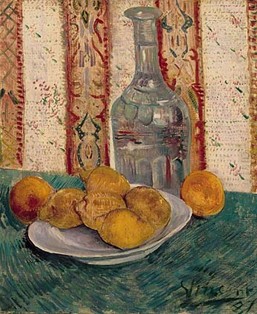 Van Gogh was a sophisticate14).
Van Gogh was a sophisticate14).
He was multilingual, widely traveled, well connected and well read. He’d studied Greek and Latin, and wrote powerfully and fluently in English, French and Dutch. His ties to the art market could scarcely have been stronger. Three of Van Gogh’s uncles were dealers by profession, as was his brother Theo, and for nearly seven years he had been employed in the picture trade himself in Paris and in London, Brussels and The Hague.
Van Gogh was a collector. First, he purchased British prints15). “I now have a good thousand sheets of English [wood engravings16)], American and French,” he wrote in 1882. Then, with Theo, he bought graphics from Japan. In 1887, he arranged a public art show—not of his own paintings, but of flatly patterned, boldly colored Ukiyoe17) woodblock prints. His vast originality obscures his many borrowings. He copied the Japanese. The Courtesan (1887) imitates a Keisai Eisen18) print he’d discovered on the cover of a Paris magazine. Still Life with Carafe and Lemons (1887) is reminiscent19) of Cezanne20). Van Gogh also copied Rembrandt21), and, in 1889, Delacroix22)’s Pieta.
He borrowed to the end. Daubigny23)’s Garden (1890), a landscape he completed the month before he killed himself, bows in two directions—toward Daubigny’s own landscapes and toward Claude Monet24)’s.
“Uncle told me that Daubigny had died. I freely confess that I was downcast when I heard the news, just as I was when I heard that Brion had died (his Bénédicité hangs in my room), because the work of such men, if it is understood, touches us more deeply than one realizes. It must be good to die in the knowledge that one has done some truthful work and to know that, as a result, one will live on.”
—Vincent van Gogh to Theo van Gogh, 3 March 1878
梵高见多识广,老于世故。
他精通多国语言,游历广泛,结交众多,博览群书。他学过希腊语和拉丁语,能够用英语、法语和荷兰语生动、流畅地写作。他和艺术品市场有着无比紧密的联系。梵高的弟弟西奥和三个叔叔都是职业掮客,而他本人在将近七年的时间里也一直在巴黎、伦敦、布鲁塞尔和海牙从事绘画交易行业。
梵高是一个收藏家。首先,他购买了许多英国的版画。“我现在有上千张英国、美国和法国的木版画。”他在1882年写道。接着,他又和西奥一起从日本购买了版画艺术作品。1887年,他举办了一场公开艺术展——展出的不是他自己的绘画作品,而是线条简练、色彩大胆的浮世绘木版画。广阔的艺术独创性掩盖了他对众多作品的借鉴。他模仿过日本艺术。《交际花》(1887)就是他模仿在巴黎的一本杂志封面上看到的溪斋英泉的版画作品。《玻璃瓶和柠檬静物写生》则使人联想到塞尚的作品。此外,梵高还模仿过伦勃朗。1889年,他又模仿了德拉克罗瓦的《圣母怜子图》。
直到生命的最后,他都没有停止过借鉴。《杜比尼花园》是他自杀前一个月完成的风景画,这幅画就体现出两种风格:一种是杜比尼本人的风景画风格,一种是克劳德·莫奈的画风。
“叔叔告诉我说杜比尼去世了。坦白地说,听到这个消息时我的情绪非常低落,正如我听到布里翁去世时的感受一样(我房间里就挂着他的画作《魅力》),因为他们的作品对我们的触动将远远超出人们的想象——如果人们能够真正理解的话。在临终之时,能够知道自己创造出了真正不朽的艺术杰作,而且个人的生命也将因此得以延续,一定是件让人颇感欣慰的事。”
——文森特·梵高1878年3月3日致西奥·梵高
3. The Palette Explodes 激情洋溢的调色板 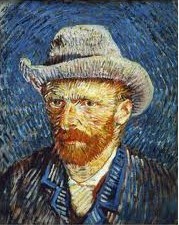 When Van Gogh moved to Paris, in March 1886, he seemed to have caught fire: He was suddenly a colorist. The incandescent25) canvases on which his reputation rests followed his conversion. He painted them all in the last four years of his life.
When Van Gogh moved to Paris, in March 1886, he seemed to have caught fire: He was suddenly a colorist. The incandescent25) canvases on which his reputation rests followed his conversion. He painted them all in the last four years of his life.
Before, he’d kept to middle tones, seeking “the gray harmony”. Now, he turned to flaming reds, blues, oranges and yellows. Before, he’d practiced shading. Now, he saw it was “impossible” to deal at the same time with saturated26) hues and subtle tonal values27). “One has to choose,” he wrote, and what he chose was color.
He used little bits of colored yarn to help compose his color chords. He no longer mixed his hues when he put them on his palette. Henceforth, he built his images of rhythmic, rhyming paint strokes, marking that his brush put down one color at a time.
“I shall be an obstinate colorist,” he wrote.
“The color laws,” he said, “are unutterably beautiful.”
In Self-Portrait with Felt Hat (1887~1888), a force field of color reverberates around his head like a ringing halo.
“It is my belief that it is actually one’s duty to paint the rich and magnificent aspects of nature. We need gaiety and happiness, hope and love… The more ugly, old, mean, ill, poor I get, the more I want to take my revenge by producing a brilliant colour, well arranged, resplendent.”
—Vincent van Gogh to Wilhelmina van Gogh28), 9 and 16 September 1888
1886年3月,梵高迁居巴黎之后,整个人似乎燃烧起来:他突然变成了调色大师。随之而来的,是他赖以成名的光芒四射的艺术杰作。而所有这些杰作都是在他生命最后的四年时间里完成的。
从前,他遵循的是中间色调,寻求“灰色的和谐”。现在,他转向鲜艳明亮的红色、蓝色、橙色和黄色。从前,他多用明暗技法。现在,他发现一个人不可能同时兼顾饱满的色彩和微妙的淡色调。“必须要作出选择。”他写道。而他选择的是色彩。
他使用细小的彩色纱线来辅助他谱写色彩的和弦(编者注:即采用“点彩法”进行绘画,用画笔以色点形式塑造形象,色点是未经调和的纯色)。他将不同的色彩置于调色板上时,不再将它们调和在一起。自此,他创作的形象一笔一画都充满了韵律和节奏感。这也表明,他的画笔每次出笔着色时,都只用一种颜色。
“我是个顽固不化的调色师。”他写道。
“色彩的法则美轮美奂,没有任何语言可以表达。”他说。
在《带毡帽的自画像》(1887~1888)中,一个由色彩构成的力场回荡在他的头像周围,仿佛一圈缠绵缭绕的光晕。
“我相信,描绘大自然丰富而壮丽的一面是画家的职责。我们需要快乐、幸福、希望和爱……我越是丑陋、衰老、卑微、贫困和疾病缠身,我就越想创造出绚丽的色彩——巧妙搭配、灿烂夺目的色彩——来为自己复仇。”
——文森特·梵高1888年9月9日和16日致威廉敏娜·梵高
4. The Shadow 阴影 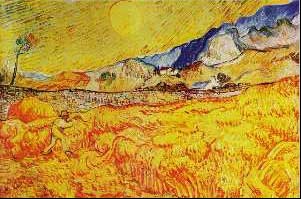 Van Gogh pulled the trigger among yellow fields of wheat on July 27, 1890. He died two days later in his brother’s arms.
Van Gogh pulled the trigger among yellow fields of wheat on July 27, 1890. He died two days later in his brother’s arms.
“Vast fields of wheat under troubled skies” glow in his last paintings. His drawing and his coloring (with Van Gogh, the two are one) were still as strong as ever, and his long-neglected work at last was gaining notice, when he seized these final images. Their yellows shine like heated gold. Beyond the warming sunlight, the chilling dark descends.
He long had known that shadow. His letters had for years voiced his intense suffering, his “overwhelming boredom”, his loneliness and loathing. He wrote: “It is only when I stand painting before my easel that I feel in any way alive.”
His episodes of madness had been growing more acute. When seized by his attacks he had put a razor to his ear lobe, or swallowed clods of dirt, or turpentine29) and paints. Just days before his suicide he felt his life attacked, he wrote, “at its very root” .
In Wheat Field with a Reaper (1889), Van Gogh had pictured death “on the point of smiling” .
“I see in this reaper—a vague figure toiling away for all he is worth30) in the midst of the heat to finish his task—I see in him the image of death, in the sense that humanity might be the wheat that he is reaping… But there is no sadness in this death; this one takes place in broad daylight with a sun flooding everything with a light of pure gold… It’s an image of death as the great book of nature speaks of it—but the effect I’ve been looking for is—‘on the point of smiling’. It’s all yellow, except for a line of purple hills. A pale and golden yellow. I find it odd that I saw it like that through the iron bars of a cell.”
—Vincent van Gogh to Theo van Gogh, 5 or 6, September 1889
In the end, Van Gogh welcomed dying. The black and jagged birds in Wheat Field with Crows, his final painting, predict what soon would come. Armed with a revolver, Van Gogh shot himself.
1890年7月27日,在一片金色的麦田里,梵高扣动了扳机。两天后,他死在了弟弟的怀抱里。
“乌云翻滚的天空下广袤的麦田”闪耀在他最后的绘画作品中。他的线条和着色(对梵高来说,二者是同一回事)仍然和以前一样遒劲有力,而他埋没已久的作品却因他抓住了这最后的意象终于引起了人们的关注。金黄的色彩仿佛受热的金子熠熠闪光。然而,在温暖的阳光背后,寒冷的黑暗降临了。
这片阴影他熟知已久。数年以来,他在信中一直诉说他强烈的痛苦和“极度的厌倦”,他的孤独与憎恶。他写道:“只有当我站在画架前绘画时,我才感到自己还活着。”
他的精神病病情越来越严重。病症发作时,他曾用一把剃刀割自己的耳垂,或者吞食土块、松脂和颜料。就在他自杀的前几天,他感觉自己的生命受到了重击,“被连根拔起”,他写道。
在《麦田里的收割者》(1889)中,梵高描绘了“面含微笑的”死神。
“一个模糊的身影,在酷暑中不辞辛苦,拼命劳作,来完成自己的任务——在这个收割者身上,我看到死亡的身影,人类仿佛就是他正在收割的麦子……但在这种死亡中没有忧伤,这种死亡发生在晴朗的天空之下,阳光给万物都染上了一层纯净的金色。这是大自然这部鸿篇巨著所描绘的死亡形象——但我一直想要追求的效果是‘面含微笑’。除了一抹紫色的山丘,一切都是金黄色。淡淡的金黄色。奇怪的是,我看到的仿佛是透过囚室铁窗的那种光色。”
——文森特·梵高1889年9月5日(或6日)致西奥·梵高
终于,梵高拥抱了死亡。在他最后的画作《麦田里的乌鸦》中,聒噪的黑色乌鸦预示了即将发生的一切。梵高用一支左轮手枪结束了自己的生命。
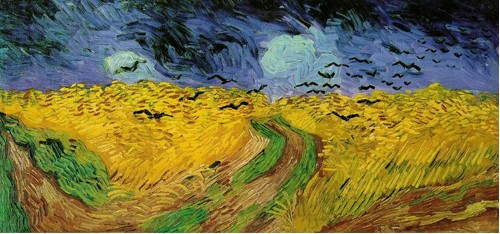
Leaving behind a tormented and emotionally disastrous past fraught with despair and sorrow, Vincent van Gogh’s artistic contribution is unrivalled in its emotional complexity and the sheer power of a tormented soul’s creative capacity. He created some of the most enduring images of all time. We see them now, and they appear to us as old friends. Stars and trees, etched upon our conscious. This is perhaps Van Gogh’s greatest gift to us: The depth of his passion transformed through the tragedy of madness into visions that transcend time and space and become tangible visual icons of the human experience.
梵高走了,将他饱受折磨、精神错乱、充满绝望与悲伤的不幸过去抛在了身后。从情感的复杂性和作为一个痛苦灵魂所产生的巨大创造力来看,文森特·梵高的艺术贡献是无与伦比的。他创造出了人类历史上最为持久的若干形象。我们至今仍可看到这些形象,对我们来说,它们就如同老朋友一样。他笔下的星星和树木都铭刻在我们的意识之中。这也许是梵高给我们留下的最伟大的礼物:强烈的激情,在精神癫狂的悲剧作用下,化为穿越时空的景象,成为人类经验触手可及的视觉符号。
1. Theo van Gogh:西奥·梵高(1857~1891),文森特·梵高的弟弟, 成功的艺术品商人
2. prolific [prE5lIfIk] adj. 多产的,作品丰富的
3. protean [prEu5ti:En] adj. 变化多端的,多才多艺的
4. evangelical [7i:vAn5dVelIkEl] adj. 福音的,新教会的
5. stolid [5stClId] adj. 不动感情的,缺乏热情的,冷淡的
6. detonate [5detEuneIt] vi. 引爆,爆炸
7. combustible [kEm5bQstEbl] adj. 易燃的
8. rustic [5rQstIk] n.〈常贬〉乡巴佬,土包子
9. out of:来自
10. Bruegel:即彼得·勃鲁盖尔(Pieter Bruegel, 1525~1569),16世纪尼德兰地区最伟大的画家。他一生以农村生活作为艺术创作的题材,被人们称为“农民的勃鲁盖尔”。
11. Nuenen:纽南,位于荷兰北布拉邦特省的一个小镇
12. belligerent [bE5lIdVErEnt] adj. 好战的,爱寻衅的
13. connoisseur [7kCnE5sE:(r)] n. (艺术品的)鉴赏家,鉴定家
14. sophisticate [sE5fIstIkeIt] n. 久经世故的人,老油条,精于……之道的人
15. print [prInt] n. (用照相制版法制造的艺术品原作的)复制品;印出的版画(或木刻画等)
16. engraving [In5^reIvIN] n. 雕版印刷品,版画
17. ukiyoe [ju5ki:jEujeI] n. (日本的)浮世绘
18. Keisai Eisen:溪斋英泉(1791~1848),日本浮世绘画家
19. reminiscent [7remI5nIsEnt] adj. 发人回想的,发人联想的
20. Cezanne:即保罗·塞尚(Paul Cezanne, 1839~1906),后印象主义的代表画家,被尊奉为“现代绘画之父”。
21. Rembrandt:即伦勃朗·哈尔曼松·凡·莱因(Rembrandt Harmenszoon van Rijn, 1606~1669),欧洲17世纪最伟大的画家之一,也是荷兰历史上最伟大的画家。
22. Delacroix:即欧仁·德拉克罗瓦(Eugène Delacroix, 1798 ~1863),法国著名画家,浪漫主义画派的典型代表
23. Daubigny:即查理-法兰斯瓦·杜比尼(Charles-François Daubigny, 1817~1878),法国巴比松派的风景画家,被认为是印象派的重要先驱之一。
24. Claude Monet:克劳德·莫奈(1840~1926),法国画家,印象派代表人物和创始人之一
25. incandescent [7InkAn5desEnt] adj. 遇热发光的,白炽的
26. saturated [5sAtFEreItId] adj. 饱和的
27. value [5vAlju:] n. [画](色彩的)浓淡关系,明暗程度
28. Wilhelmina van Gogh:威廉敏娜·梵高(1862~1941),文森特·梵高的妹妹,最早的女权主义者之一
29. turpentine [5tE:pEntaIn] n. 松脂
30. for all one is worth:〈口〉尽力,拼命
